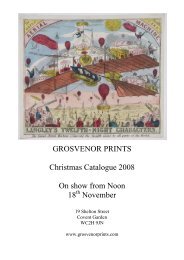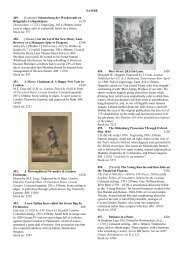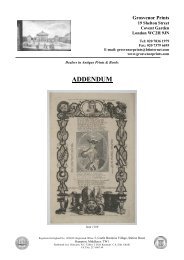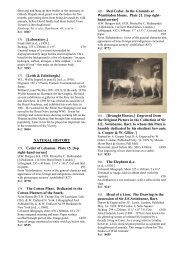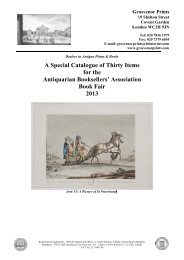cat2 09.pdf - Grosvenor Prints
cat2 09.pdf - Grosvenor Prints
cat2 09.pdf - Grosvenor Prints
Create successful ePaper yourself
Turn your PDF publications into a flip-book with our unique Google optimized e-Paper software.
Blore, forming three wings around a central courtyard.<br />
Buckingham Palace finally became the official royal<br />
palace of the British monarch on the accession of<br />
Queen Victoria in 1837.<br />
Plate to Volume III of Rudolph Ackermann's<br />
'Microcosm of London', 3 vols., 1808-10.<br />
Numbered 'Plate 65.' upper right.<br />
Abbey, Scenery of Great Britain and Ireland: 212, 65.<br />
9866 Trinity House.<br />
Rowlandson & Pugin delt. et sculpt. Sutherland aquat.<br />
London Pub. Octr. 1st. 1809, at R. Ackermann’s<br />
Repository of Arts 101 Strand.<br />
Hand coloured aquatint, 240 x 270mm. 9½ x 10½".<br />
£160<br />
Interior view of a meeting at Trinity House. The<br />
Corporation of Trinity House came into being in 1514<br />
by Royal Charter granted by Henry VIII. Trinity House<br />
has three main functions: The care of all lighthouses in<br />
England, Wales, the Channel Islands and Gibraltar.<br />
Providing aids to navigation, e.g. lightvessels,<br />
lighthouses, buoys, radio navigation services etc.<br />
Serving as a charitable organisation for mariners;<br />
looking after their safety, welfare, training etc.<br />
The Corporation also inspects buoys etc provided by<br />
local harbour authorities, and provides a Deep Sea<br />
Pilot Service. It no longer provides local pilots for<br />
entering ports. Trinity House is financed from “Light<br />
Dues” levied on commercial shipping calling at ports<br />
in the United Kingdom.<br />
The Masters of the Corporation of Trinity House have<br />
included the diarist Samuel Pepys and the Duke of<br />
Wellington, and Admiral William Penn (father of<br />
William Penn, founder of Pennsylvania).<br />
Plate to Volume III of Rudolph Ackermann's<br />
'Microcosm of London', 3 vols., 1808-10.<br />
Numbered 'Plate 87.' upper right.<br />
Abbey, Scenery of Great Britain and Ireland: 212, 88.<br />
9865 Vauxhall Garden.<br />
Rowlandson & Pugin delt. et sculpt. J. Bluck, aquat.<br />
London Pub. Octr. 1st. 1809, at R. Ackermann’s<br />
Repository of Arts 101 Strand.<br />
Hand coloured aquatint, 280 x 230mm. 11 x 9". £220<br />
An illuminated band stand at Vauxhall Gardens, a<br />
pleasure garden and one of the leading venues for<br />
public entertainment in London from the mid 17th<br />
century to the mid 19th century. Revellers dance in the<br />
foreground.<br />
Plate to Volume III of Rudolph Ackermann's<br />
'Microcosm of London', 3 vols., 1808-10.<br />
Numbered 'Plate 88.' upper right.<br />
Abbey, Scenery of Great Britain and Ireland: 212, 89.<br />
9864 West India Docks.<br />
Rowlandson & Pugin delt. et sculpt. Bluck aquat.<br />
London Pub. Jany. 1. 1810, at R. Ackermann’s<br />
Repository of Arts 101 Strand.<br />
Hand coloured aquatint, 235 x 280mm. 9¼ x 11". £190<br />
A view of the newly-built West India Docks on the Isle<br />
of Dogs in London. Outraged at losses due to theft and<br />
delay at London's riverside wharves, Robert Milligan<br />
(c. 1746 - 1809) headed a group of powerful<br />
businessmen, including the chairman of the West India<br />
Merchants of London, George Hibbert, who promoted<br />
the creation of a wet dock circled by a high wall. The<br />
Docks were constructed in two phases. The two<br />
northern-most docks were constructed between 1800<br />
and 1802 (officially opened on 27 August 1802) for the<br />
West India Dock Company to a design by leading civil<br />
engineer William Jessop (John Rennie was a<br />
consultant), and were the first commercial wet docks in<br />
London.<br />
Plate to Volume III of Rudolph Ackermann's<br />
'Microcosm of London', 3 vols., 1808-10.<br />
Numbered 'Plate 92.' upper right. On Whatman paper<br />
watermarked 1808.<br />
Abbey, Scenery of Great Britain and Ireland: 212, 92.<br />
9750 View principally comprising<br />
Marylebone Manor House, gardens, park<br />
and Environs, as they probably stood in the<br />
time of Q. Elizabeth, when her Majesty<br />
entertained the Russian ambassadors with<br />
hunting in the said park. From an original<br />
drawing made by Gasselin in 1700. See<br />
Pennant's London 3. edit. and Lyson's<br />
Middx.___ In this House a considerable<br />
School was kept many years by Mr. De la<br />
place, and after by Mr. Fountaine; on<br />
whose Succession the building was<br />
demolished in 1791. This Plate is<br />
Dedicated to the Noblemen and Gentlemen<br />
Educated at the Said School By Their<br />
Very Humble Servant John Thomas Smith.<br />
[Published by J.T. Smith, 1800.]<br />
Etching and aquatint, sheet 145 x 510mm. 5¾ x 20".<br />
Trimmed within plate and into aquatint frame left and<br />
right. Laid into album page. £220<br />
View of the St. Marylebone Manor House, park and<br />
gardens, as they might have appeared in the time of<br />
Queen Elizabeth I. The manor house was demolished<br />
in 1791, and was close to the first site of the<br />
Marylebone Cricket Club, founded by Thomas Lord<br />
(1755 - 1832) in 1787.<br />
Published by John Thomas Smith (1766 - 1833),<br />
probably a plate to 'Antiquities of London and<br />
Environs engrav’d and publish’d by J. T. Smith ...<br />
containing many curious houses, monuments and<br />
statues ... from original drawings; ... with remarks and<br />
references to the works of ... Pennant, Stowe, etc' 1791<br />
-1800. Known as 'Antiquity' Smith, he was Keeper of<br />
<strong>Prints</strong> & Drawings at the British Museum 1816-1833.<br />
He was author of a number of books on London and its<br />
history, as well as 'Nollekens and his Times' (1828)<br />
and 'A Book for Rainy Day' (posthumous). He was son<br />
of Nathaniel Smith and apprenticed to J.K.Sherwin,<br />
then on stage, and next a drawing master. He<br />
succeeded in books of London antiquarian topography<br />
from 1791 onwards.<br />
Guildhall Library: p5386381.




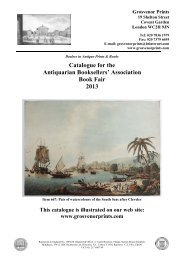
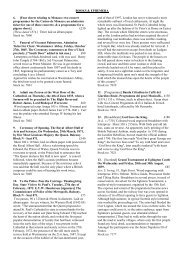
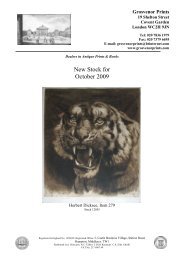
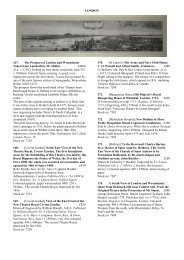
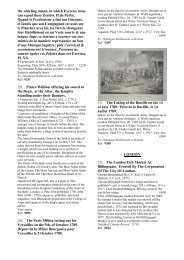
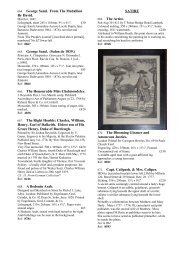
![FOREIGN TOPOGRAPHY 661. [Niagara] The ... - Grosvenor Prints](https://img.yumpu.com/38432042/1/184x260/foreign-topography-661-niagara-the-grosvenor-prints.jpg?quality=85)
